Regional Inequality in China Based on NPP-VIIRS Night-Time Light Imagery
Abstract
:1. Introduction
2. Methods and Data
2.1. Methods
2.1.1. Two-Stage Nested Theil Decomposition Method
2.1.2. Correction of the NPP-VIIRS NTL Data
2.2. Data
2.2.1. Visible Infrared Imaging Radiometer Suite Night-Time Light Imagery
2.2.2. Economic and Demographic Data
3. Results
3.1. Correction Results of NPP-VIIRS NTL Data
3.2. Accuracy Assessment of GDP Estimation
3.3. Decomposition of Theil Inequality Indices
3.3.1. Total Inequality and Its Decomposed Components
3.3.2. Economic Inequality within Provinces
3.4. Relationship between Regional Inequality and Economic Development
4. Discussion
5. Conclusions
- The NPP-VIIRS NTL data were found to exhibit a strong capacity in reflecting the real status of the regional economy. This result is in line with previous studies [13,30]. After correction, the VIIRS NTL data showed a statistically positive correlation with GDP. In every year, the R2 for all years in the study period was above 0.82. This proves that our correction method is scientifically effective.
- The results of two-stage nested Theil decomposition indicate that overall inequality, within-province inequality and between-region inequality in China all declined from 2014 to 2017. However, between-province inequality increased slightly. As for the contributions of these components to the overall regional income, the within-province inequality was the highest, followed by the between-region inequality, while the between-province inequality was the lowest. Moreover, further analysis of within-province inequality reveals that location has played a significant role in shaping China’s uneven economic landscape. Specifically, economic inequalities in coastal provinces are smaller than are those in inland provinces.
- Using scatter plots, we have found that China’s economic development plays an important role in affecting regional inequality. Furthermore, the extent of the influence of economic development on regional inequality varies across provinces. In particular, the regional inequalities in relatively backward areas are more obvious than are those in relatively developed areas.
- Currently, a series of NPP-VIIRS NTL data are released, in particular, annual composite products are being released. As NOAA/NGDC is working to produce more NPP-VIIRS data, further research can be focused on multi-temporal image analysis for revealing the spatiotemporal dynamics of regional inequality in China at multi-scale. In addition, various types of data, such as vegetation index data, land cover data shall be applied to correct the NPP-VIIRS NTL data. In this way, more detailed relationship between corrected NTL data and GDP will be revealed, and application of NTL data in investigating regional inequalities would be more reliable, which are the directions in further research.
Acknowledgments
Author Contributions
Conflicts of Interest
References
- He, C.; Chen, T.; Mao, X.; Zhou, Y. Economic transition, urbanization and population redistribution in China. Habitat Int. 2016, 51, 39–47. [Google Scholar] [CrossRef]
- National Bureau of Statistics of China (NBSC). Chinese Statistics Yearbook; NBSC: Beijing, China, 2016.
- Pedroni, P.; Yao, J.Y. Regional income divergence in China. J. Asian Econ. 2006, 17, 294–315. [Google Scholar] [CrossRef]
- Lu, S.; Guan, X.; Yu, D.; Deng, Y.; Zhou, L. Multi-Scale Analysis of Regional Inequality based on Spatial Field Model: A Case Study of China from 2000 to 2012. ISPRS Int. J. Geo-Inf. 2015, 4, 1982–2003. [Google Scholar] [CrossRef]
- Li, C.; Gibson, J. Rising Regional Inequality in China: Fact or Artifact? World Dev. 2013, 47, 16–29. [Google Scholar] [CrossRef]
- Sun, M.; Fan, C.C. Regional Inequality in China, 1978–2006. Eurasian Geogr. Econ. 2008, 49, 1–18. [Google Scholar] [CrossRef]
- He, S.; Bayrak, M.M.; Lin, H. A comparative analysis of multi-scalar regional inequality in China. Geoforum 2017, 78, 1–11. [Google Scholar] [CrossRef]
- Li, Y.; Wei, Y.H.D. The spatial-temporal hierarchy of regional inequality of China. Appl. Geogr. 2010, 30, 303–316. [Google Scholar] [CrossRef]
- Wei, Y.D. Spatiality of regional inequality. Appl. Geogr. 2015, 61, 1–10. [Google Scholar] [CrossRef]
- Sun, W.; Lin, X.; Liang, Y.; Li, L. Regional Inequality in Underdeveloped Areas: A Case Study of Guizhou Province in China. Sustainability 2016, 8, 1141. [Google Scholar] [CrossRef]
- Ye, X.; Ma, L.; Ye, K.; Chen, J.; Xie, Q. Analysis of Regional Inequality from Sectoral Structure, Spatial Policy and Economic Development: A Case Study of Chongqing, China. Sustainability 2017, 9, 633. [Google Scholar] [CrossRef]
- Ghosh, T.; Anderson, S.; Elvidge, C.; Sutton, P. Using Nighttime Satellite Imagery as a Proxy Measure of Human Well-Being. Sustainability 2013, 5, 4988–5019. [Google Scholar] [CrossRef]
- Zhou, Y.; Ma, T.; Zhou, C.; Xu, T. Nighttime Light Derived Assessment of Regional Inequality of Socioeconomic Development in China. Remote Sens. 2015, 7, 1242–1262. [Google Scholar] [CrossRef]
- Chinese province admits falsifying economic data for years. Governor Chen Qiufa of Liaoning. Available online: http://www.chinadaily.com.cn/kindle/2017-01/18/content_27989234.htm (accessed on 1 October 2017).
- Shi, K.; Chen, Y.; Yu, B.; Xu, T.; Yang, C.; Li, L.; Huang, C.; Chen, Z.; Liu, R.; Wu, J. Detecting spatiotemporal dynamics of global electric power consumption using DMSP-OLS nighttime stable light data. Appl. Energy 2016, 184, 450–463. [Google Scholar] [CrossRef]
- Liu, Z.; He, C.; Zhang, Q.; Huang, Q.; Yang, Y. Extracting the dynamics of urban expansion in China using DMSP-OLS nighttime light data from 1992 to 2008. Landsc. Urban Plan. 2012, 106, 62–72. [Google Scholar] [CrossRef]
- He, C.; Ma, Q.; Liu, Z.; Zhang, Q. Modeling the spatiotemporal dynamics of electric power consumption in Mainland China using saturation-corrected DMSP/OLS nighttime stable light data. Int. J. Digit. Earth 2013, 7, 993–1014. [Google Scholar] [CrossRef]
- Shi, K.; Chen, Y.; Yu, B.; Xu, T.; Chen, Z.; Liu, R.; Li, L.; Wu, J. Modeling spatiotemporal CO2 (carbon dioxide) emission dynamics in China from DMSP-OLS nighttime stable light data using panel data analysis. Appl. Energy 2016, 168, 523–533. [Google Scholar] [CrossRef]
- Ghosh, T.; Elvidge, C.D.; Sutton, P.C.; Baugh, K.E.; Ziskin, D.; Tuttle, B.T. Creating a Global Grid of Distributed Fossil Fuel CO2 Emissions from Nighttime Satellite Imagery. Energies 2010, 3, 1895–1913. [Google Scholar] [CrossRef]
- Coscieme, L.; Pulselli, F.M.; Bastianoni, S.; Elvidge, C.D.; Anderson, S.; Sutton, P.C. A Thermodynamic Geography: Night-Time Satellite Imagery as a Proxy Measure of Emergy. Ambio 2014, 43, 969–979. [Google Scholar] [CrossRef] [PubMed]
- Lessmann, C.; Seidel, A. Regional inequality, convergence, and its determinants—A view from outer space. Eur. Econ. Rev. 2017, 92, 110–132. [Google Scholar] [CrossRef]
- Elvidge, C.D.; Sutton, P.C.; Ghosh, T.; Tuttle, B.T.; Baugh, K.E.; Bhaduri, B.; Bright, E. A global poverty map derived from satellite data. Comput. Geosci. 2009, 35, 1652–1660. [Google Scholar] [CrossRef]
- Xu, H.; Yang, H.; Li, X.; Jin, H.; Li, D. Multi-Scale Measurement of Regional Inequality in Mainland China during 2005–2010 Using DMSP/OLS Night Light Imagery and Population Density Grid Data. Sustainability 2015, 7, 13469–13499. [Google Scholar] [CrossRef]
- Elvidge, C.D.; Baugh, K.E.; Anderson, S.J.; Sutton, P.C.; Ghosh, T. The Night Light Development Index (NLDI): A spatially explicit measure of human development from satellite data. Soc. Geogr. 2012, 7, 23–35. [Google Scholar] [CrossRef]
- Coscieme, L.; Sutton, P.C.; Anderson, S.; Liu, Q.; Elvidge, C.D. Dark Times: Nighttime satellite imagery as a detector of regional disparity and the geography of conflict. GISci. Remote Sens. 2017, 54, 118–139. [Google Scholar] [CrossRef]
- Zhao, M.; Cheng, W.; Zhou, C.; Li, M.; Wang, N.; Liu, Q. GDP Spatialization and Economic Differences in South China Based on NPP-VIIRS Nighttime Light Imagery. Remote Sens. 2017, 9, 673. [Google Scholar] [CrossRef]
- Ou, J.; Liu, X.; Li, X.; Li, M.; Li, W. Evaluation of NPP-VIIRS Nighttime Light Data for Mapping Global Fossil Fuel Combustion CO2 Emissions: A Comparison with DMSP-OLS Nighttime Light Data. PLoS ONE 2015, 10, e0138310. [Google Scholar] [CrossRef] [PubMed]
- Sharma, R.C.; Tateishi, R.; Hara, K.; Gharechelou, S.; Iizuka, K. Global mapping of urban built-up areas of year 2014 by combining MODIS multispectral data with VIIRS nighttime light data. Int. J. Digit. Earth 2016, 9, 1004–1020. [Google Scholar] [CrossRef]
- Gao, B.; Huang, Q.; He, C.; Dou, Y. Similarities and differences of city-size distributions in three main urban agglomerations of China from 1992 to 2015: A comparative study based on nighttime light data. J. Geogr. Sci. 2017, 27, 533–545. [Google Scholar] [CrossRef]
- Shi, K.; Yu, B.; Huang, Y.; Hu, Y.; Yin, B.; Chen, Z.; Chen, L.; Wu, J. Evaluating the Ability of NPP-VIIRS Nighttime Light Data to Estimate the Gross Domestic Product and the Electric Power Consumption of China at Multiple Scales: A Comparison with DMSP-OLS Data. Remote Sens. 2014, 6, 1705–1724. [Google Scholar] [CrossRef]
- Li, X.; Xu, H.; Chen, X.; Li, C. Potential of NPP-VIIRS Nighttime Light Imagery for Modeling the Regional Economy of China. Remote Sens. 2013, 5, 3057–3081. [Google Scholar] [CrossRef]
- Ma, T.; Zhou, C.; Pei, T.; Haynie, S.; Fan, J. Responses of Suomi-NPP VIIRS-derived nighttime lights to socioeconomic activity in China’s cities. Remote Sens. Lett. 2014, 5, 165–174. [Google Scholar] [CrossRef]
- Clarke-Sather, A.; Qu, J.; Wang, Q.; Zeng, J.; Li, Y. Carbon inequality at the sub-national scale: A case study of provincial-level inequality in CO2 emissions in China 1997–2007. Energy Policy 2011, 39, 5420–5428. [Google Scholar] [CrossRef]
- Akita, T. Decomposing regional income inequality in China and Indonesia using two-stage nested Theil decomposition method. Ann. Reg. Sci. 2003, 37, 55–77. [Google Scholar] [CrossRef]
- NEW—2015 VIIRS Nighttime Lights Annual Composite is Available. The Earth Observations Group (EOG). Available online: https://ngdc.noaa.gov/eog/viirs/download_dnb_composites.html (accessed on 1 October 2017).
- Mills, S.; Weiss, S.; Liang, C. VIIRS day/night band (DNB) stray light characterization and correction. Proc. SPIE 2013, 8866. [Google Scholar] [CrossRef]
- Levin, N.; Zhang, Q. A global analysis of factors controlling VIIRS nighttime light levels from densely populated areas. Remote Sens. Environ. 2017, 190, 366–382. [Google Scholar] [CrossRef]
- Levin, N. The impact of seasonal changes on observed nighttime brightness from 2014 to 2015 monthly VIIRS DNB composites. Remote Sens. Environ. 2017, 193, 150–164. [Google Scholar] [CrossRef]
- Liu, J.; Chen, R.; Song, Y. Distribution and Variation of Snow Cover in China. Progress. Inquis. Mutat. Clim. 2012, 8, 364–371. (In Chinese) [Google Scholar] [CrossRef]
- National Bureau of Statistics of China (NBSC). China Statistical Yearbook for Regional Economy, 2013–2015; NBSC: Beijing, China, 2015.
- Kuznets, S. Economic Growth and Income Inequality. Am. Econ. Rev. 1955, 45, 1–28. Available online: http://www.jstor.org/stable/1811581?seq=5#page_scan_tab_contents (accessed on 1 October 2017).
- Dai, Z.; Hu, Y.; Zhao, G. The Suitability of Different Nighttime Light Data for GDP Estimation at Different Spatial Scales and Regional Levels. Sustainability 2017, 9, 305. [Google Scholar] [CrossRef]
- Xu, M.; He, C.; Liu, Z.; Dou, Y. How Did Urban Land Expand in China between 1992 and 2015? A Multi-Scale Landscape Analysis. PLoS ONE 2016, 11, e0154839. [Google Scholar] [CrossRef] [PubMed]
- Long, Y.; Wu, K. Shrinking cities in a rapidly urbanizing China. Environ. Plan. A 2016, 48, 220–222. [Google Scholar] [CrossRef]
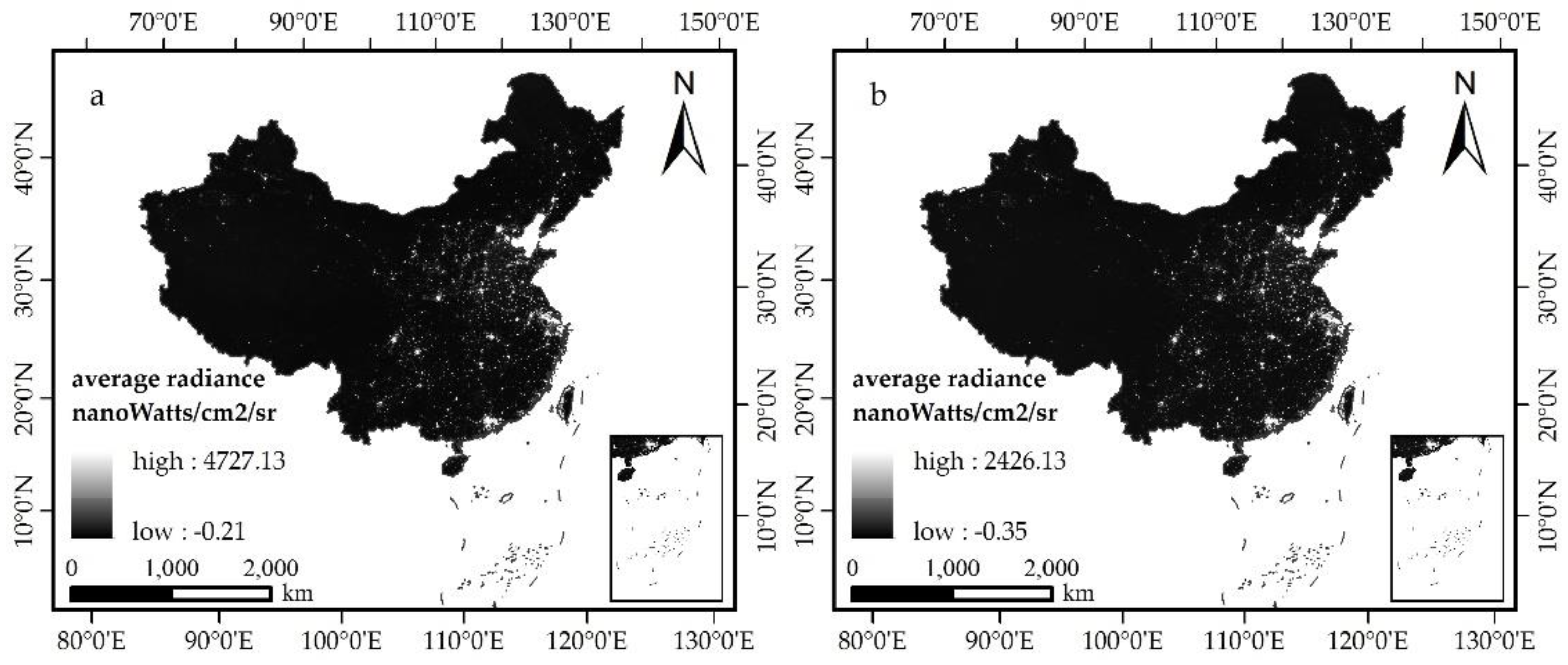
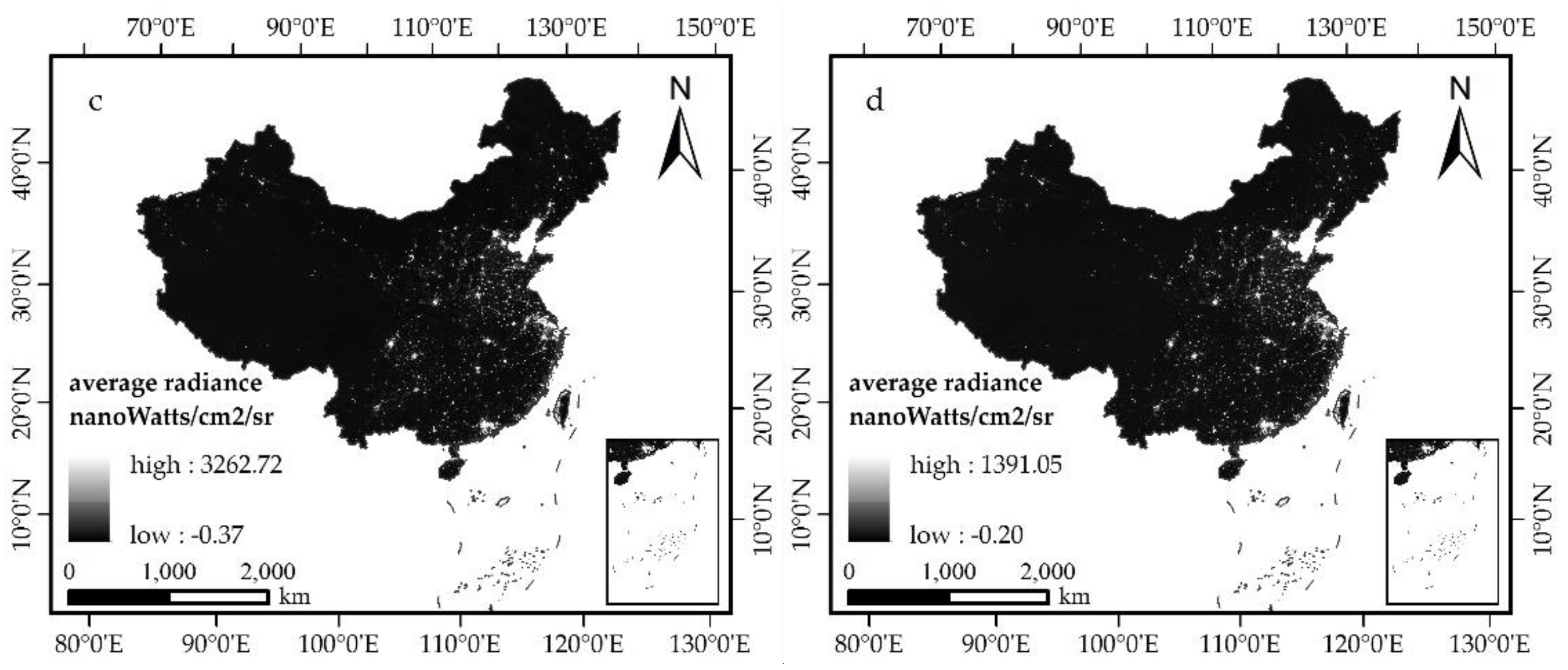
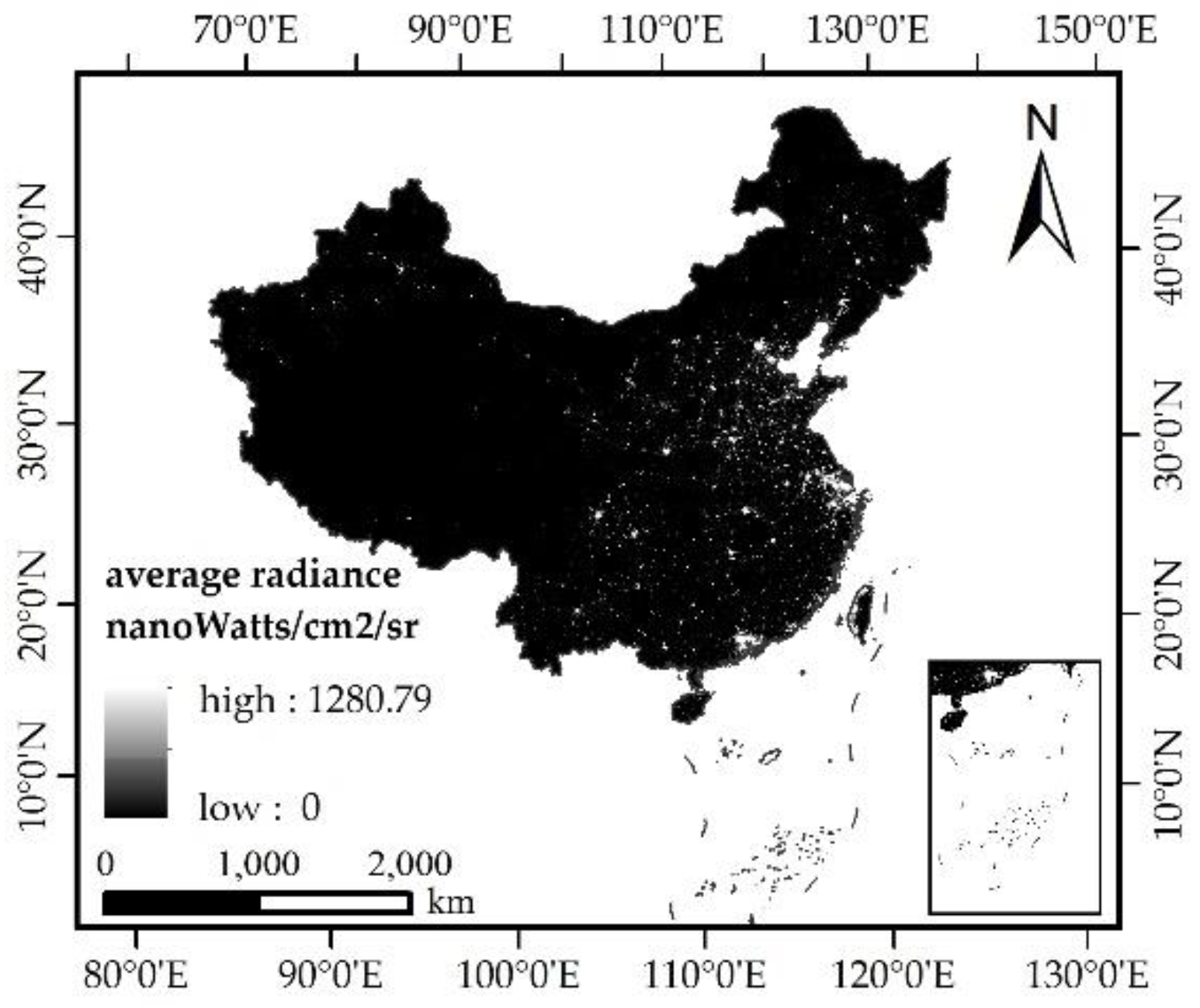
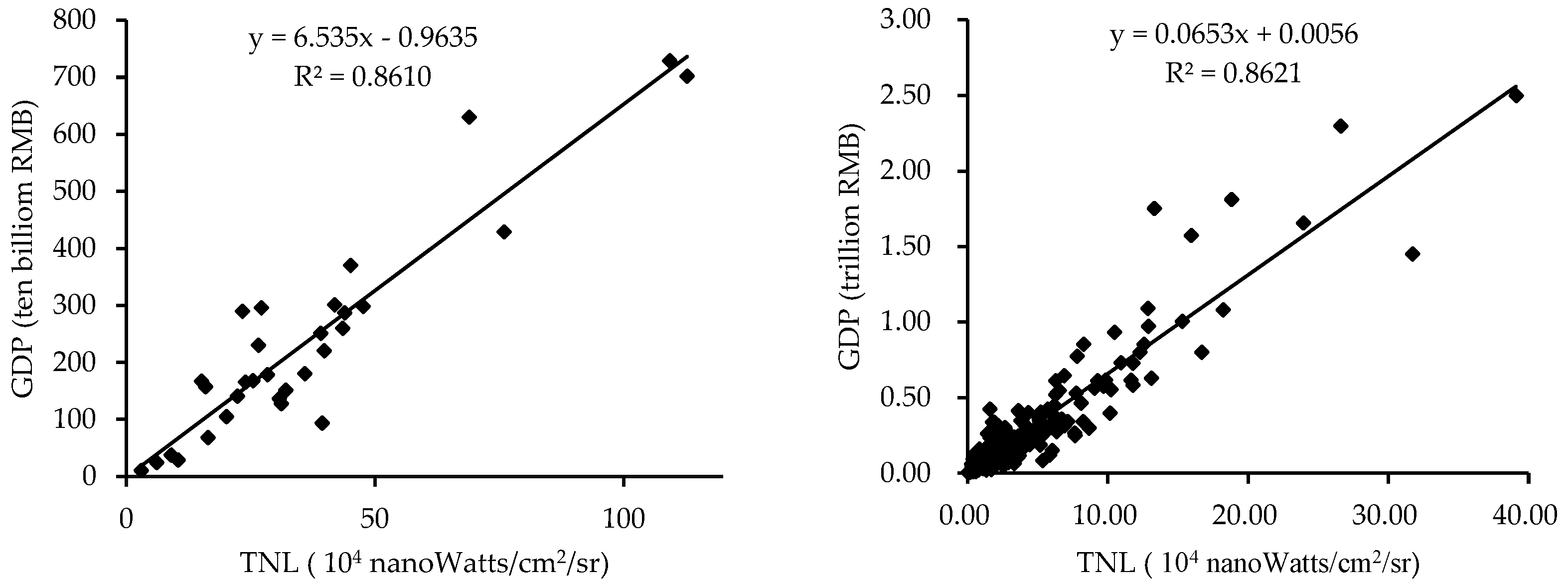
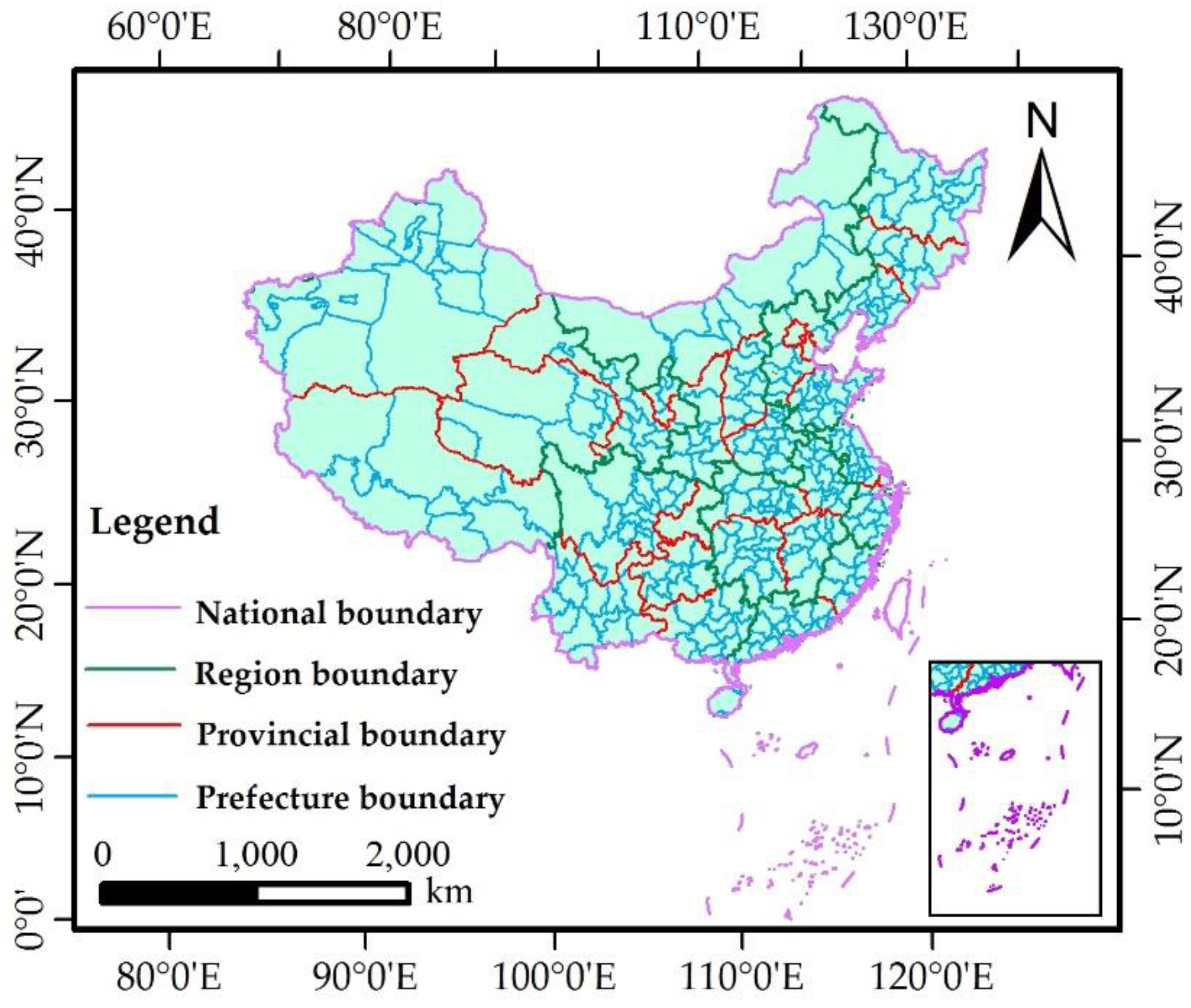
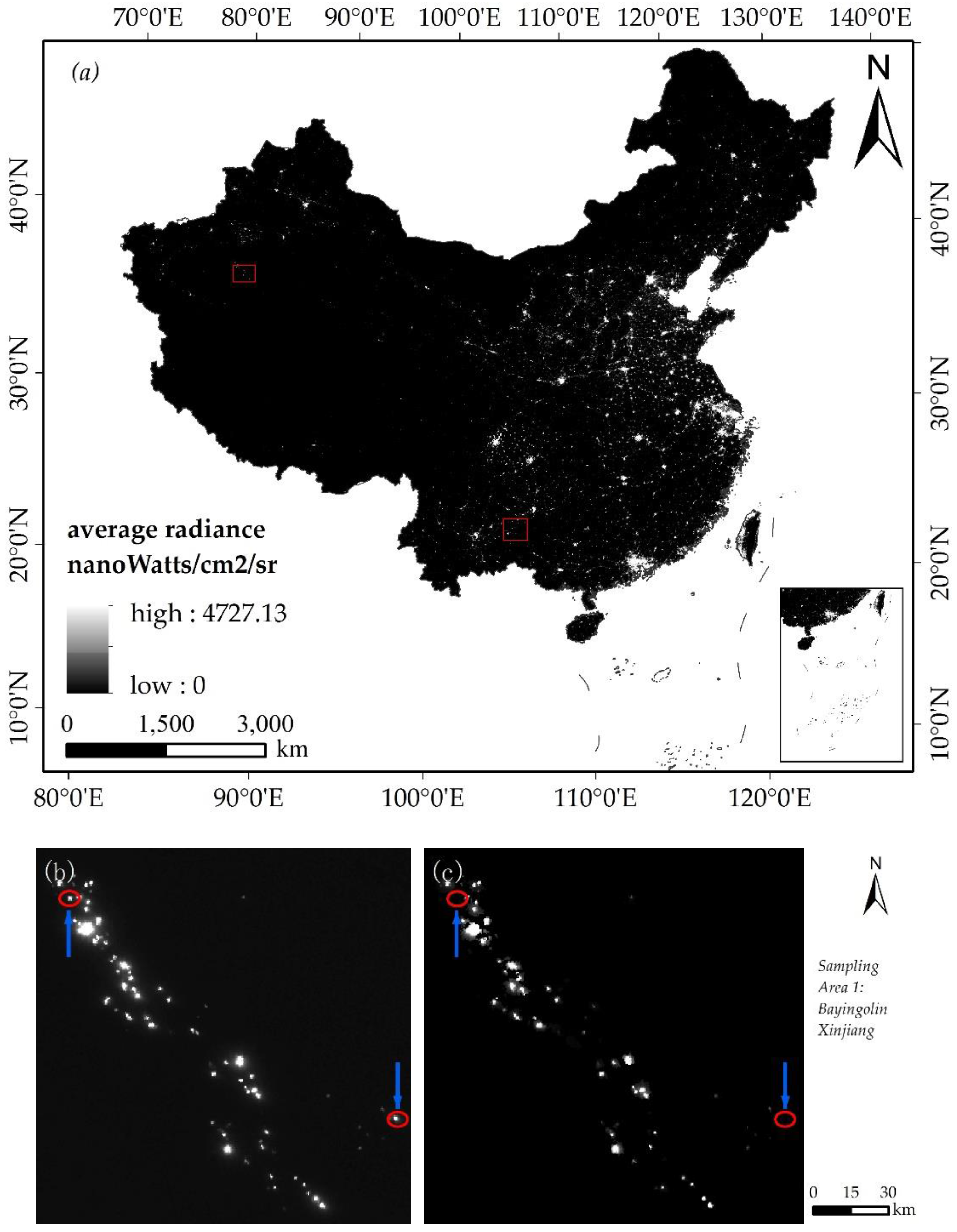
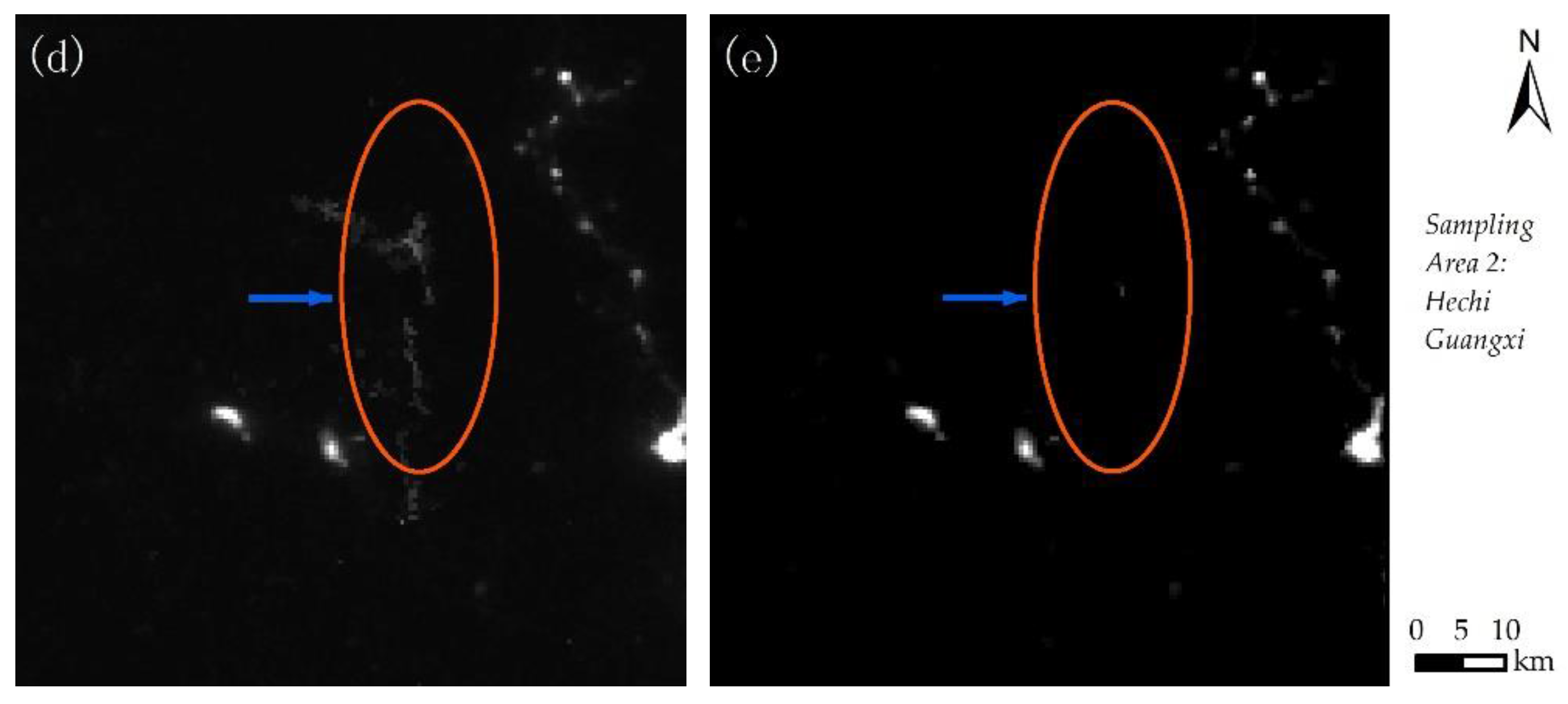
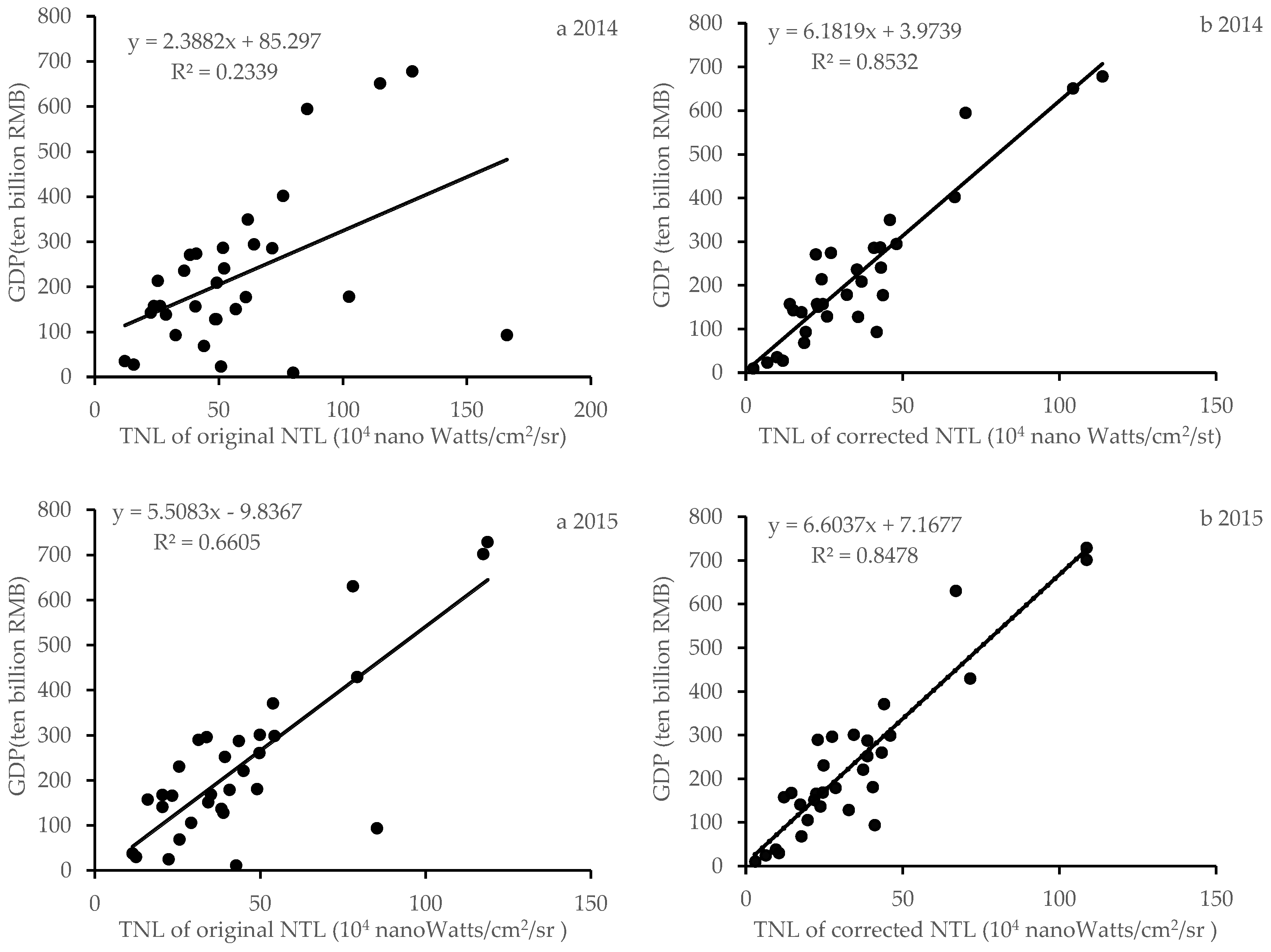
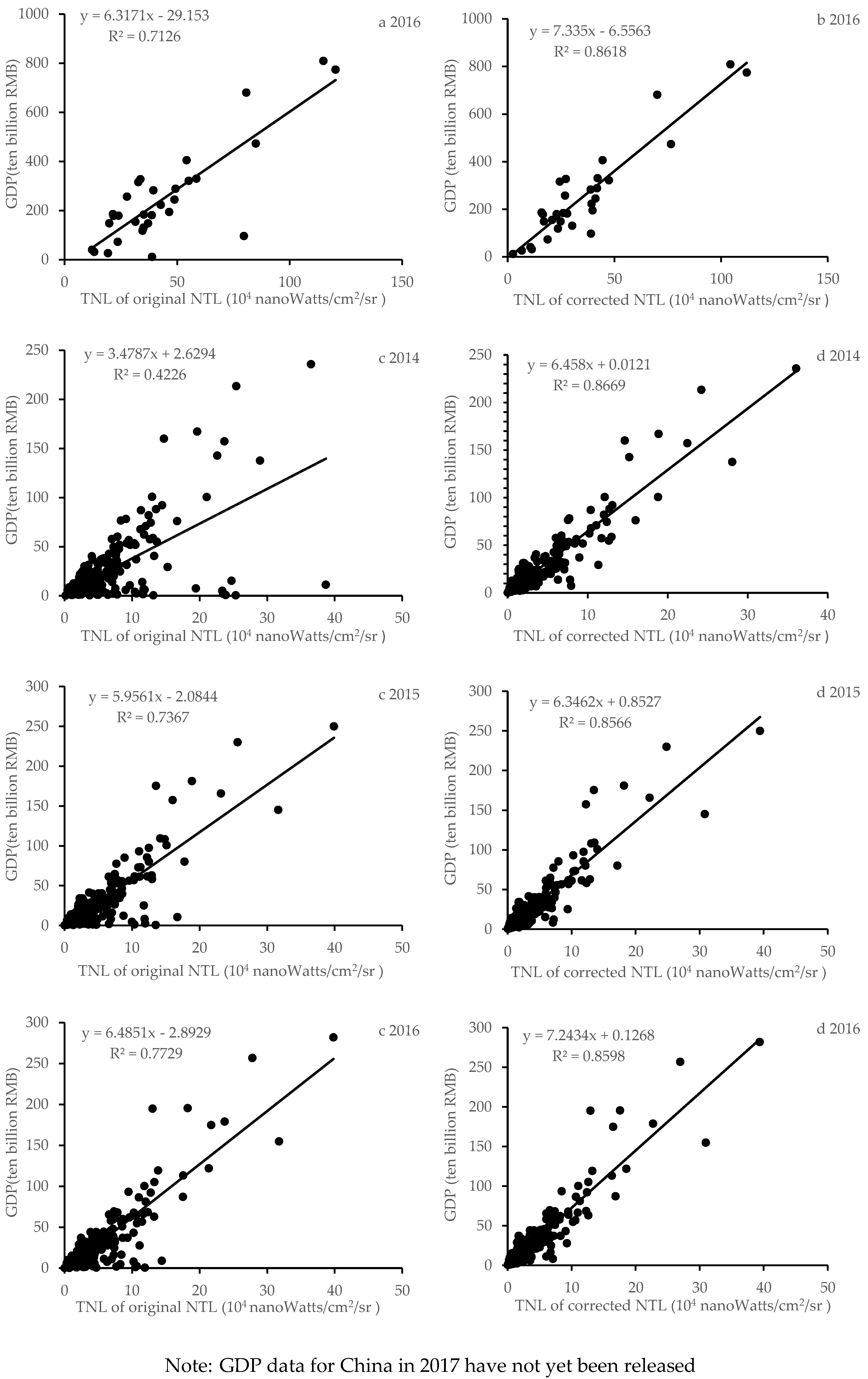

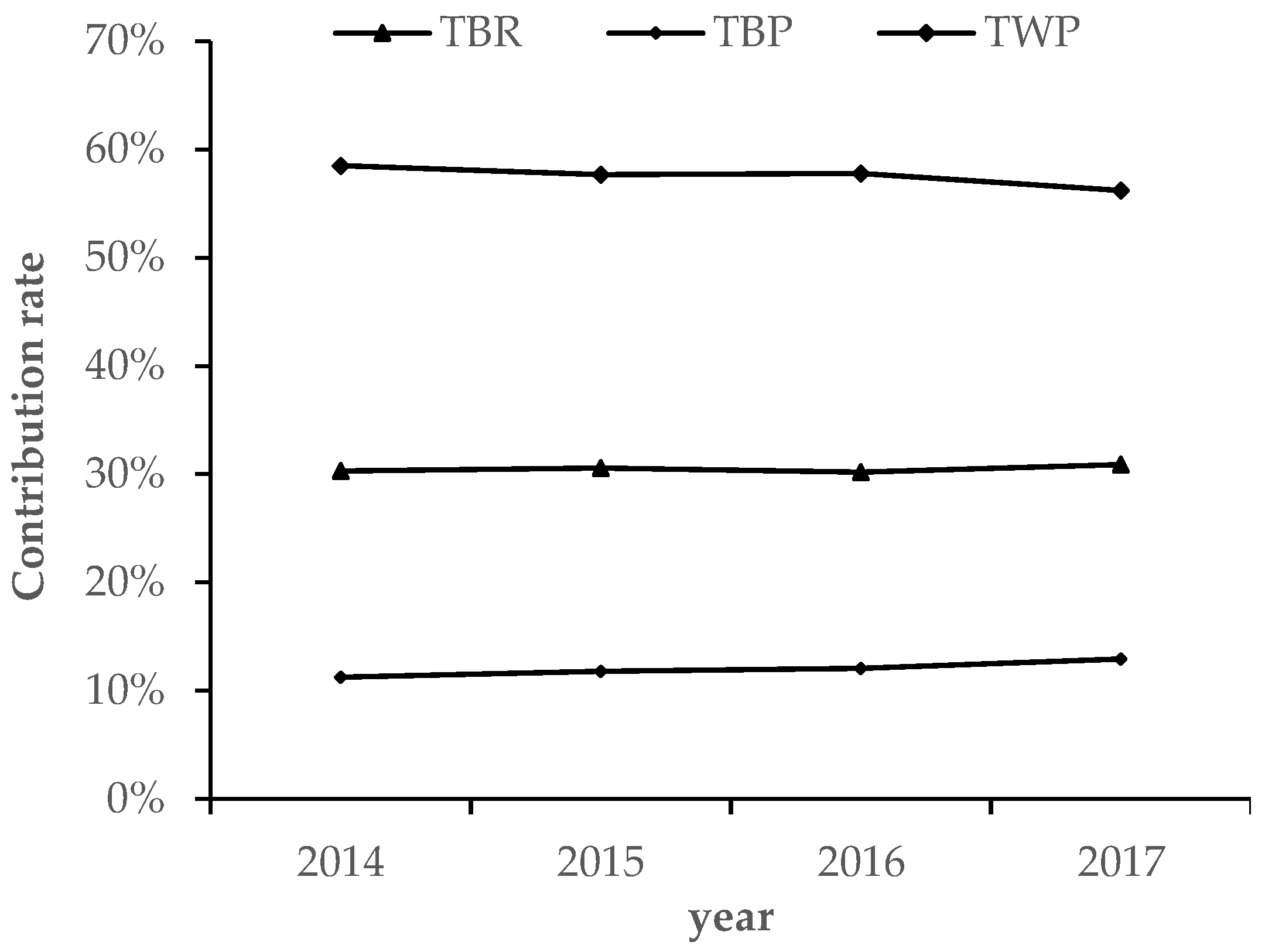
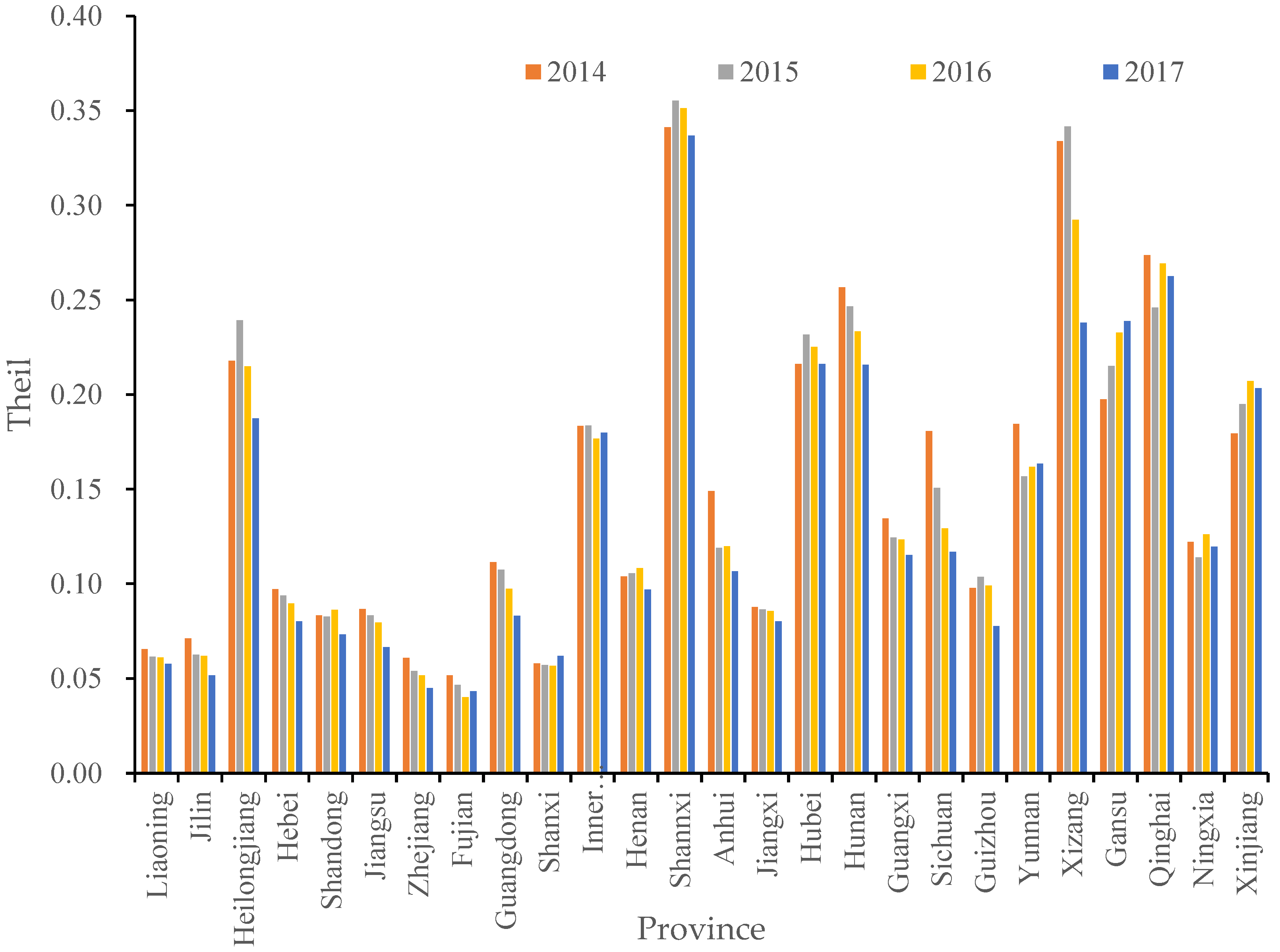
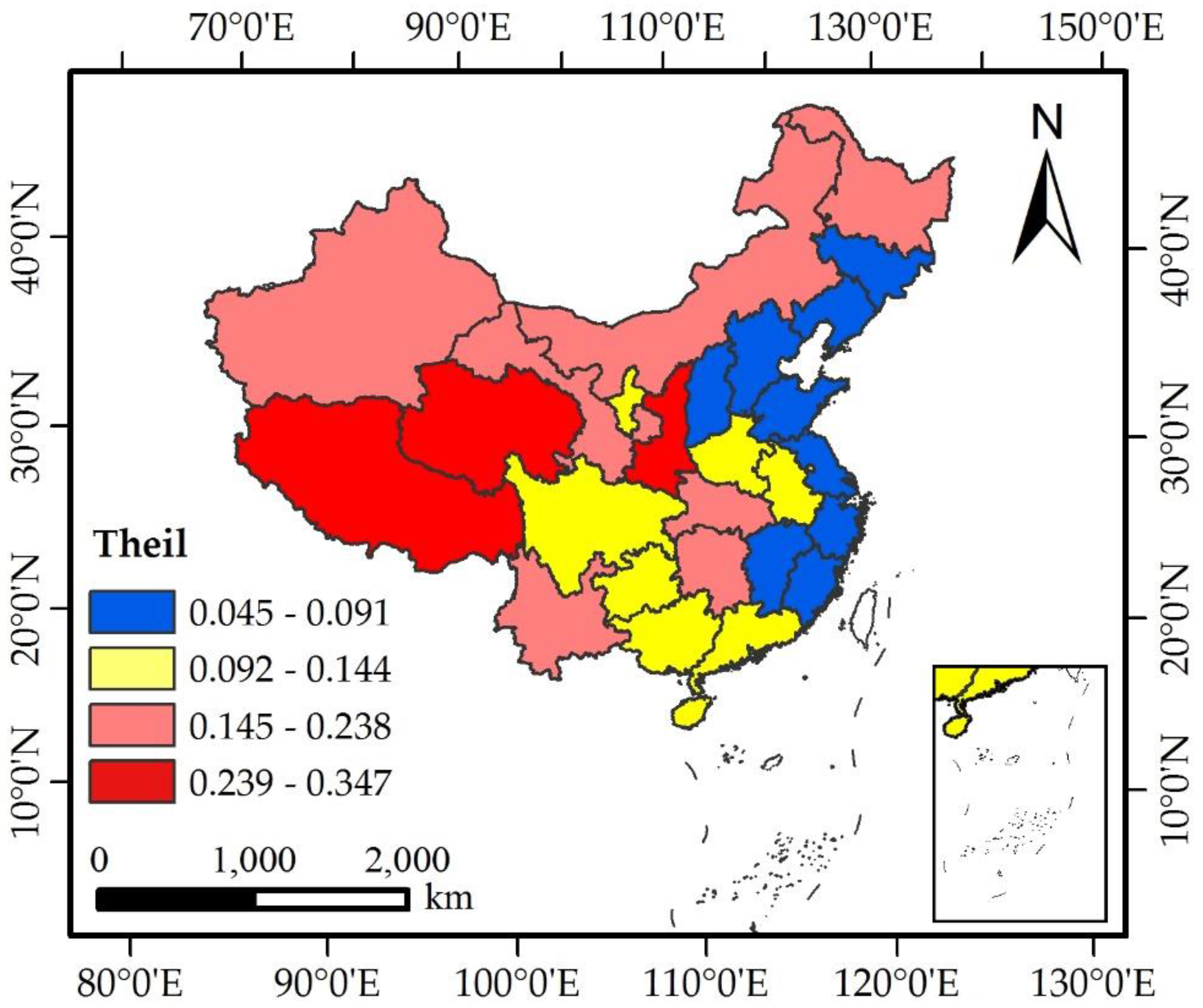
| Province | R2 | Formula |
|---|---|---|
| Liaoning | R2 = 0.9430 | y = −0.0003x + 0.0991 |
| Jilin | R2 = 0.9586 | y = −0.0007x + 0.1164 |
| Heilongjiang | R2 = 0.4869 | y = −0.0014x + 0.3177 |
| Hebei | R2 = 0.9571 | y = −0.0007x + 0.1605 |
| Shandong | R2 = 0.4656 | y = −0.0004x + 0.1162 |
| Jiangsu | R2 = 0.9772 | y = −0.0006x + 0.1857 |
| Zhejiang | R2 = 0.9862 | y = −0.0003x + 0.0984 |
| Fujian | R2 = 0.4414 | y = −0.0002x + 0.0697 |
| Guangdong | R2 = 0.9573 | y = −0.0012x + 0.244 |
| Shanxi | R2 = 0.4529 | y = 0.0001x + 0.0434 |
| Inner Monglia | R2 = 0.3667 | y = −9 × 10−5x + 0.1942 |
| Henan | R2 = 0.5402 | y = 0.0002x + 0.0947 |
| Shannxi | R2 = 0.0344 | y = −1 × 10−4x + 0.3593 |
| Anhui | R2 = 0.7787 | y = −0.0013x + 0.2219 |
| Jiangxi | R2 = 0.9278 | y = −0.0004x + 0.1015 |
| Hubei | R2 = 0.0071 | y = −9 × 10−5x + 0.2273 |
| Hunan | R2 = 0.9951 | y = −0.0029x + 0.3534 |
| Guangxi | R2 = 0.9491 | y = −0.0009x + 0.1816 |
| Sichuan | R2 = 0.9835 | y = −0.0045x + 0.403 |
| Guizhou | R2 = 0.5099 | y = −0.0005x + 0.1338 |
| Yunnan | R2 = 0.2847 | y = −0.0006x + 0.2043 |
| Xizang | R2 = 0.6399 | y = −0.0015x + 0.4700 |
| Gansu | R2 = 0.4529 | y = 0.0001x + 0.0434 |
| Qinghai | R2 = 0.0115 | y = −6 × 10−5x + 0.2716 |
| Ningxia | R2 = 0.0122 | y = 2 × 10−5x + 0.1164 |
| Xinjiang | R2 = 0.8017 | y = 0.0003x + 0.1323 |
© 2018 by the authors. Licensee MDPI, Basel, Switzerland. This article is an open access article distributed under the terms and conditions of the Creative Commons Attribution (CC BY) license (http://creativecommons.org/licenses/by/4.0/).
Share and Cite
Wu, R.; Yang, D.; Dong, J.; Zhang, L.; Xia, F. Regional Inequality in China Based on NPP-VIIRS Night-Time Light Imagery. Remote Sens. 2018, 10, 240. https://doi.org/10.3390/rs10020240
Wu R, Yang D, Dong J, Zhang L, Xia F. Regional Inequality in China Based on NPP-VIIRS Night-Time Light Imagery. Remote Sensing. 2018; 10(2):240. https://doi.org/10.3390/rs10020240
Chicago/Turabian StyleWu, Rongwei, Degang Yang, Jiefang Dong, Lu Zhang, and Fuqiang Xia. 2018. "Regional Inequality in China Based on NPP-VIIRS Night-Time Light Imagery" Remote Sensing 10, no. 2: 240. https://doi.org/10.3390/rs10020240






